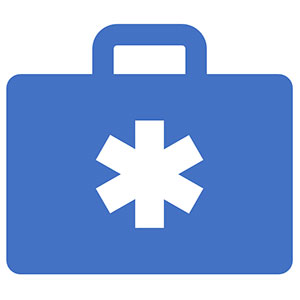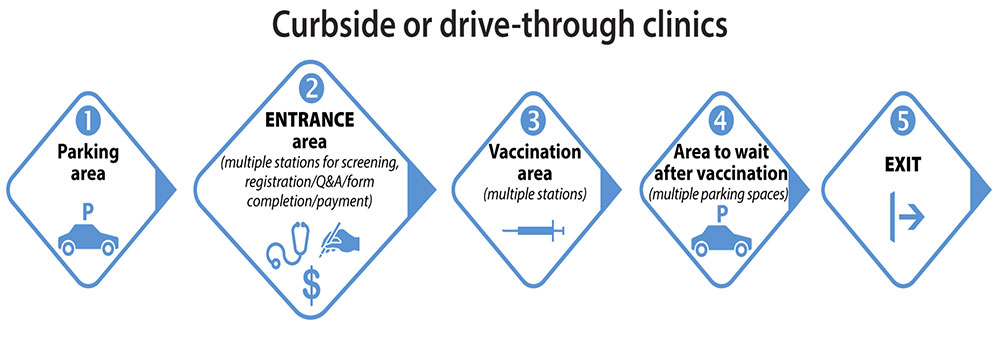Pre-Clinic Activities
Establish the purpose and goal(s) of your clinic, including target population, whether it is open to the public or only for specific groups, numbers of people to be vaccinated, and vaccine(s) to be offered. Once the purpose is established, identify mission-essential staffing and resources appropriate for the clinic location and size.

Supplies and Materials
Secure sufficient supplies to meet the needs of staff and the highest anticipated number of patients. Recommended supplies can be found here: Satellite, Temporary, and Off-Site Vaccination Clinic Supply Checklist | CDC:

Training
Staff training is critical. Ensure all staff is trained to answer common questions about the vaccine.
Ensure clinical staff is trained in:
- Cardiopulmonary resuscitation (CPR) and basic life support (BLS)
- Infection prevention and control practices
- Vaccine storage, handling, preparation, and administration for the vaccine(s) being offered, using manufacturer instructions for the vaccine and CDC and Advisory Committee on Immunization Practices (ACIP) guidance found in:
- CDC’s Vaccine Storage and Handling Toolkit
- Vaccine Administration Recommendations and Guidelines
- You Call the Shots training programs about specific vaccines
- How and where to document vaccines administered
- Recognition and management of severe allergic reactions and syncope
Training should include an observation component. Validate staff knowledge of and skills in vaccine administration with a skills checklist.
Cross-train staff, if possible, to enable flexibility in meeting needs at various clinic stations as demand fluctuates.
A plan for medical management of an adverse event should also be in place and clinical staff should understand their roles in implementing the plan, including:
- Recognition and management of severe allergic reactions
- Prevention and recognition of syncope

Vaccine Storage and Handling
Ensure plans are in place for transporting and maintaining vaccine at appropriate temperatures while it is stored and throughout the clinic day based on vaccine storage and handling guidance.
A contingency plan should also be in place, in case vaccines are delayed or compromised and need to be replaced.

Vaccination Clinic Layout
Considerations for vaccination clinic layout include:
- Design the clinic flow so it moves in one direction and avoids crowding, with separate entrance and exit areas. Use rope or cones, tape, and signs in multiple languages, as needed, outside the clinic entrance area and inside the clinic to show routes for patients to follow from station to station.
- Designate an area for vaccine preparation. Vaccines should not be prepared at individual vaccination stations. Only administer vaccines you have prepared to reduce errors.
-
- See Medication Preparation Questions and the Vaccine Administration Resource Library for additional guidance.
- Designate areas for people with disabilities or limited mobility, including places to sit while waiting.
- If more than one vaccine is offered, prepare and administer different vaccines at different stations to reduce administration errors.
- Provide adequate seating for patients in waiting areas and a table and seating for both the patient and vaccinator at each vaccination station for walk-through clinics.
- Provide dividers between stations and at least one privacy screen in case patients need to remove clothing to bare their arms for vaccination at walk-through clinics.
- Provide a private area where clients who experience acute adverse events after vaccination or who have medical problems can be evaluated and treated.
- Provide a protected area for staff to leave personal items and take breaks.
- Provide a separate administrative work area for on-site documentation of vaccination in the IIS or electronic health record (EHR), if applicable. If not done on site, plans must be in place for how vaccinations will be documented after the clinic.



Clinic Promotion and Communication
To promote your clinic:
- Be clear about who the clinic is for—those who have an appointment, those who have been prescreened, healthcare workers, high-risk populations, etc. Use signage at the clinic to provide this information, including where to get vaccinated if someone doesn’t meet the clinic criteria.
- Provide instructions on how to set up appointments if prescheduling will be used.
- Scale your promotion to the amount of vaccine that will be available.
- Use multilingual and multimedia channels to widely post clinic purpose, dates, locations, times, and population that will be served.
Be prepared to:
- Communicate other options if scheduling is unable to meet demands (e.g., direct patients to other facilities, if possible).
- Use electronic communication, as appropriate, to share clinic information such as asking patients to download screening forms or review the VIS(s) or EUA fact sheets before coming to the clinic.

Electronic Testing
- Test connections and operability of any computers, tablets, printers, and barcode readers.

Clinic Security
- Consider using a uniformed security guard to assist in managing crowds.
- Designate a space or system to secure vaccine and protect clinic staff and their valuables.
